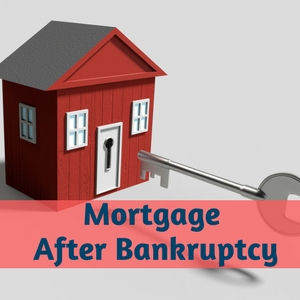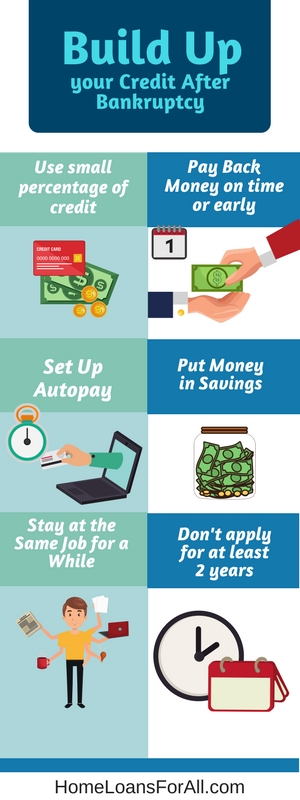
Can you really have a mortgage after bankruptcy? People who have declared bankruptcy often wonder if it is still possible for them to obtain a mortgage in the future. Fortunately, the answer is a resounding yes! Many families are still eligible to receive a new mortgage after declaring bankruptcy if they can follow the proper steps to obtain lender approval.
The first thing you need to do is to have the bankruptcy discharged. While this might sound like a monumental task, it is a normal part of the bankruptcy process. The discharge simply means that you have been released from all of the debts you previously owed. You might need to go about this differently depending on whether you had a Chapter 7 or a Chapter 13 bankruptcy.
We Can Help You Qualify For a Mortgage After Bankruptcy
Fill Out The Form Below To Get Help Today!
Depending on the circumstances and the filing method, you will need to either follow your repayment plan or simply wait for the discharge to occur. Under a Chapter 7 bankruptcy, you will typically receive your discharge four months after filing.
Chapter 13 bankruptcies take longer because they involve repayment plans. This might require three to five years’ worth of these payments before you are released from the debt.
Once the discharge happens, you can finally move forward with the necessary steps to obtain a new mortgage. Homeownership will once again be in your future if you can adhere to some of these key steps.
What Do I Need to Do Before Applying?
Before you can head straight to the bank to talk about buying a house after Chapter 7 and a foreclosure, you will need to take a few proactive steps. These steps can help you to receive a mortgage after Chapter 7 discharge with more favorable terms and in a much timelier manner than might otherwise be possible.
Prove to lenders you can pay the money back
 Getting the discharge isn’t going to be enough to demonstrate to your lender that you are ready to take responsibility for a new mortgage.
Getting the discharge isn’t going to be enough to demonstrate to your lender that you are ready to take responsibility for a new mortgage.
If they are going to loan you a substantial amount of money, you will ultimately need to prove that you can be trusted to repay it. This doesn’t require a specified period of time, but there are definitely a few steps you can take to make it more likely that lenders will issue financing for your new home.
The first step is to get a secured credit card. These cards require you to make a deposit amount for the “credit line” that the bank is willing to issue you. Each month, you can use this small limit to purchase groceries, gas, or other inexpensive items that you know can be repaid. Be certain to pay your credit card bill on time each month to demonstrate that you can handle this responsibility.
The other step that many individuals will take to prove their creditworthiness is to take out an installment loan. An installment loan is any type of loan that features set monthly payments over a specified period of time.
Fixed-rate mortgages are a great example of installment loans, but you can also receive them in much smaller quantities. You can use these to pay for car repairs, a new car, or to pay off unforeseen medical bills. Much like the secured credit card, it’s imperative that you make the payments on time each month without fail.
Both of these simple suggestions can prove to lenders that you have learned a great deal of fiscal responsibility following your bankruptcy. You won’t be able to convince them of your creditworthiness overnight, but these small steps can add up to long-term value when done properly.
Build up your credit after bankruptcy
Filing for bankruptcy can seriously disrupt your credit score and wreak havoc on your financial status. Rebuilding your credit to resemble that of a financially healthy individual is a time-consuming process that consists of simple steps over a long period of time.
You won’t see an immediate gain in your credit score but sticking with these solutions is sure to show you a difference over time.
Use only a small percentage of available credit.
Many people automatically assume that they should max out their credit limits on their card or loan amounts. It can be misleading that lenders will issue you a line of credit but expect you not to take advantage of its full value. However, this is exactly what you need to do to demonstrate financial trustworthiness. Experts recommend that you only utilize about thirty percent of your available credit at any given time.
Do you already have credit cards that are reaching their upper limits? Make a conscious effort to repay some of this debt so you can lower your overall credit utilization.
Move slowly – pay back money on time or early.
Paying things off quickly might be too much for your finances to handle if you’ve recently filed for bankruptcy. Instead, it’s a much wiser decision to take baby steps in regards to your monthly debts and payments. Make sure that every bill is paid on time or slightly early to prevent mishaps on the actual due date.
 You can set an alarm on your phone to remind you that payments are due on a specific day each month.
You can set an alarm on your phone to remind you that payments are due on a specific day each month.
Make sure you set the alarm on a day and time where you will be available to pay the bill immediately, such as a Saturday morning or a Thursday evening after work.
Set up autopay.
Instead of scheduling a time to pay your bills, you might want to consider enrolling in autopay. If any of your accounts offer an autopay feature, you can fork over your payment information and select your desired payment date. They will automatically handle the transfer of your funds without any additional action required from you.
This is an extremely convenient way to make sure that you pay back your money either on time or a few days early each month.
Put money in savings.
Having a savings account should be considered a necessity for everyone, but it is particularly essential for individuals who need to rebuild their credit. A savings account demonstrates to lenders that you have some financial flexibility to set money aside for disasters and unforeseen financial emergencies. These funds are a great way to prevent yourself from maxing out the credit card or setting the stage for late and missed payments.
Not only can savings accounts be a practical way to manage your finances, but it can also translate into your down payment when you do qualify for a new mortgage after bankruptcy. Many lenders will require a higher down payment from those who have low credit scores, so this savings account could come in handy for your new purchase.
Stay at the same job for a while.
A steady employment history can do wonders for showing lenders that you are trustworthy. They want to see that you have a reliable and steady source of income for a long period of time. This ensures that you will have the means necessary to pay off your mortgage each month, in addition to all of your other bills.
It’s recommended that you show at least a two-year history of staying within the same field of work. Your employer and the circumstances might change, but your job title and responsibilities should stay relatively the same.
Don’t apply for at least two years
There are minimum waiting periods for individuals who want to obtain a mortgage after bankruptcy. A conventional mortgage through Fannie Mae or Freddie Mac could require you to wait up to four years from the time your bankruptcy is discharged. Other lending options might be able to provide financing in as little as two years, including advantageous programs like the FHA mortgage loan.
Because there are a few necessary waiting periods, it is best not to tax yourself with attempting to secure financing until these waiting periods are up. Two years is a safe amount of time to spend rebuilding your credit, saving up for a down payment, and proving your financial trustworthiness before talking with your lender about the possibility of a loan.
Read our article on Bad Credit Home Loans and How To Get Approved here.
What Should I Do When I’m Ready to Apply for a Mortgage After Bankruptcy?
Once you know that you’re ready to start seeking out assistance and financing from a lender, it’s important that you get everything in order. There are a few steps you will still need to take to prove that you’re ready to take on the immense responsibility of a mortgage after bankruptcy. The best thing you can do is start to prepare all of your paperwork and proof now before you ever set foot in the lender’s office.
Show you have a good debt to income ratio
 Lenders want to know that you can actually afford the home you are attempting to purchase.
Lenders want to know that you can actually afford the home you are attempting to purchase.
Most of them will want to see a debt to income ratio that is 43 percent or lower. What does this mean practically? Well, it means that your total monthly debts (including your new estimated mortgage, interest, taxes, and insurance payments) will equal 43 percent or less of your gross monthly income.
You can consider this in terms of real-world numbers for a moment. Let’s say that you have $600 in debt that you pay each month that covers your student loan debt, auto loan, and credit card payment. You aren’t quite ready to purchase a home, so we won’t factor that into your debt to income calculation.
You also don’t need to add in monthly bills that are not “debts” where you have borrowed money from someone else such as your groceries or gas bills.
If you make $2,000 each month, that means that your current debt to income ratio is around thirty percent.
Round up all of your loan statements in every area to show your lender just how much you pay each month. If you find that your debt to income ratio is too high to add in a mortgage payment, you might want to start paying down some of your other loans before you apply for a new mortgage.
Show that you have money in the bank
 Lenders don’t want to issue financing to people who barely have enough money in the bank to cover their monthly bills. They want to see that you have money in both your checking and savings account to prepare adequately for the future. This should include money for your down payment as well as “rainy day” money.
Lenders don’t want to issue financing to people who barely have enough money in the bank to cover their monthly bills. They want to see that you have money in both your checking and savings account to prepare adequately for the future. This should include money for your down payment as well as “rainy day” money.
Start to take your future into consideration as well before you head to the bank. A lender might want to see your retirement savings account in addition to a regular savings account. This long-term plan can contribute to your overall financial health and demonstrate a high degree of fiscal responsibility. These are all things that a lender is bound to look for when issuing you a mortgage after bankruptcy.
Have a big down payment ready.
 When your credit score is low, lenders prefer to see other compensating factors to give them a little peace of mind for taking a risk on you.
When your credit score is low, lenders prefer to see other compensating factors to give them a little peace of mind for taking a risk on you.
One of the easiest and most common compensating factors for lenders to require is a larger down payment.
This ensures that you have more equity built up in the property before you ever move into the house. It allows them to take a much lesser risk on financing your property in the event that you filed for bankruptcy again or the mortgage moved into foreclosure.
A conventional mortgage used to require a twenty percent down payment, but many of the other financing programs are much more advantageous these days. Consider the down payment required for an FHA (Federal Housing Administration) loan.
For individuals with credit scores of 580 or higher, you will only be required to come up with a 3.5 percent down payment. Credit scores between 500 and 579 will require a substantially higher down payment of ten percent.
While this can certainly derail your plans for more immediate homeownership, it does have some benefit to you once you move in. A larger down payment lowers the principal balance on your mortgage and enables you to have lower monthly payments.
Conclusion
Getting a mortgage after bankruptcy is possible, no matter whether it was a Chapter 7 bankruptcy or a Chapter 13. You will have to wait through the acceptable waiting periods required by your lender and the specific financing program you are interested in. However, homeownership can be a realized goal in the years ahead despite your murky financial past.
You need to take the steps today to start moving toward realistic homeownership. Building your credit score, coming up with a large down payment, and getting your finances in order are essential steps toward receiving financing for a new home in the future. Evaluate where you are right now to determine the best course of action moving forward.
Frequently Asked Questions
How soon after declaring bankruptcy can I buy a home?
Most experts recommend waiting at least two years before applying for a new mortgage. Some loan programs will allow you to purchase a new home just one year after a bankruptcy discharge if there were extenuating circumstances leading up to your bankruptcy.
What is the difference between Chapter 7 and Chapter 13 bankruptcy?
A Chapter 7 bankruptcy is a liquidation bankruptcy for individuals who have little to no income and who need to pay off large amounts of debt for medical bills, credit card debt, and other varieties of loans. You might not have any assets to sell in order to cover the cost of your debts.
A Chapter 13 bankruptcy is designed for individuals who make too much money and who can afford to repay at least a portion of their debt. It is characterized by a repayment plan that might stretch out up to five years before you receive a discharge from the bankruptcy.
How long does a bankruptcy stay on my credit score?
It depends on what kind of bankruptcy you file. A Chapter 7 bankruptcy can stay on your credit report for up to ten years, while a Chapter 13 bankruptcy can stay on your report for up to seven years.
How long after bankruptcy can I buy a house?
You will likely have to wait at least two years to purchase a home after bankruptcy. However, you might be able to apply in one year if you had extenuating circumstances leading up to your bankruptcy.
Can I have a mortgage after bankruptcy?
Yes, you can have a mortgage after bankruptcy if you actively work to repair your financial status and credit score. This might require years’ worth of work, but it is possible.
Can you get a mortgage after bankruptcy and foreclosure?
Yes, you can get a mortgage after bankruptcy and fore closure if you can restore financial balance and repair your credit score.
Additional Mortgage After Bankruptcy Resources
- https://www.nytimes.com/2014/11/02/realestate/mortgages-after-bankruptcy.html
- http://www.uscourts.gov/services-forms/bankruptcy/bankruptcy-basics
Pre Qualify for a Mortgage Today, with Our Help – Even if You’ve had a Bankruptcy – Click Here.











